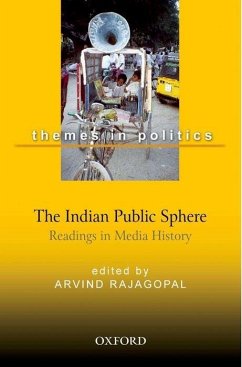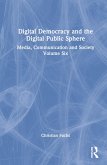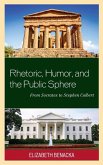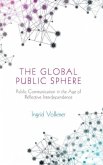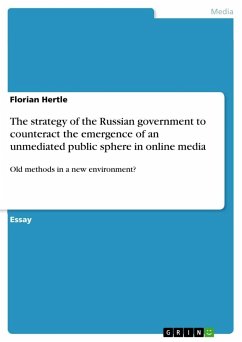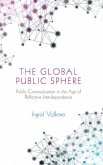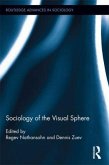The Indian Public Sphere
Readings in Media History
Herausgeber: Rajagopal, Arvind
The Indian Public Sphere
Readings in Media History
Herausgeber: Rajagopal, Arvind
- Gebundenes Buch
- Merkliste
- Auf die Merkliste
- Bewerten Bewerten
- Teilen
- Produkt teilen
- Produkterinnerung
- Produkterinnerung
This volume examines the media in the Indian public sphere and its interplay with politics, society and culture, and analyzes its transition from the colonial to the post-colonial period
Andere Kunden interessierten sich auch für
![Digital Democracy and the Digital Public Sphere Digital Democracy and the Digital Public Sphere]() Christian FuchsDigital Democracy and the Digital Public Sphere150,99 €
Christian FuchsDigital Democracy and the Digital Public Sphere150,99 €![Rhetoric, Humor, and the Public Sphere Rhetoric, Humor, and the Public Sphere]() Elizabeth BenackaRhetoric, Humor, and the Public Sphere112,99 €
Elizabeth BenackaRhetoric, Humor, and the Public Sphere112,99 €![The Global Public Sphere The Global Public Sphere]() Ingrid VolkmerThe Global Public Sphere69,99 €
Ingrid VolkmerThe Global Public Sphere69,99 €![The Indigenous Public Sphere The Indigenous Public Sphere]() Hartley JohnThe Indigenous Public Sphere239,99 €
Hartley JohnThe Indigenous Public Sphere239,99 €![The strategy of the Russian government to counteract the emergence of an unmediated public sphere in online media The strategy of the Russian government to counteract the emergence of an unmediated public sphere in online media]() Florian HertleThe strategy of the Russian government to counteract the emergence of an unmediated public sphere in online media17,95 €
Florian HertleThe strategy of the Russian government to counteract the emergence of an unmediated public sphere in online media17,95 €![The Global Public Sphere The Global Public Sphere]() Ingrid VolkmerThe Global Public Sphere24,99 €
Ingrid VolkmerThe Global Public Sphere24,99 €![Sociology of the Visual Sphere Sociology of the Visual Sphere]() Sociology of the Visual Sphere185,99 €
Sociology of the Visual Sphere185,99 €-
-
-
This volume examines the media in the Indian public sphere and its interplay with politics, society and culture, and analyzes its transition from the colonial to the post-colonial period
Produktdetails
- Produktdetails
- Verlag: Oxford University Press
- Seitenzahl: 360
- Erscheinungstermin: 16. November 2009
- Englisch
- Abmessung: 216mm x 145mm x 33mm
- Gewicht: 476g
- ISBN-13: 9780198061038
- ISBN-10: 019806103X
- Artikelnr.: 27035483
- Herstellerkennzeichnung
- Libri GmbH
- Europaallee 1
- 36244 Bad Hersfeld
- gpsr@libri.de
- Verlag: Oxford University Press
- Seitenzahl: 360
- Erscheinungstermin: 16. November 2009
- Englisch
- Abmessung: 216mm x 145mm x 33mm
- Gewicht: 476g
- ISBN-13: 9780198061038
- ISBN-10: 019806103X
- Artikelnr.: 27035483
- Herstellerkennzeichnung
- Libri GmbH
- Europaallee 1
- 36244 Bad Hersfeld
- gpsr@libri.de
Arvind Rajagopal is associate professor in the Departments of Media, Culture and Communication, Sociology, and Social and Cultural Analysis at the Steinhardt School of Culture, Education, and Human Development, New York University
* Acknowledgements, Publisher's Acknowledgements, List of Figures,
Preface;
Introduction: The Public Sphere in India: Structure and
Transformation (Arvind Rajagopal);
Section I: Formation of a Colonial Public Sphere;
* 1.2.3.4.5.6.7.: Transmission (Ranajit Guha);The Indian Ecumene: An
Indigenous Public Sphere (Christopher Bayly);The Politics of Popular
Images: From Cow Protection to M.K. Gandhi, 1890-1950 (Christopher
Pinney);Obtaining Moral Consensus in a Law and Order Society (Rajeev
Dhavan);
Section II: The National PopularRedefining Obscenity and Aesthetics
in Print (Charu Gupta);The Hindi Political Sphere (Francesca
Orsini);"Woman-Oriented" Narratives and the New Indian Woman (Purnima
Mankekar);
* 8.9.10.11.12.: Who is it that is Singing? Shot-Music-Speech (Aniket
Jaaware);
Section III: National Developmentalism and the Tensions of a Mediatic
Infrastructure;The Mahatma Didn't Like the Movies and Why it Matters:
Indian Broadcasting Policy, 1920s-1990s (Robin Jeffrey);Subliminal
Charge: How Hindi-Language Newspaper Expansion Affects India (Peter
Friedlander, Robin Jeffrey and Sanjay Seth);A Split Public in the
Making and the Unmaking of the Ramjanmabhumi Movement (Arvind
Rajagopal);Forging Public Opinion: The Press, Television and
Electoral Campaigns in Andhra Pradesh (G. Krishna Reddy);
* Section IV: Emergent Orders: Localization, Consumerism, Digital
Culture;
Preface;
Introduction: The Public Sphere in India: Structure and
Transformation (Arvind Rajagopal);
Section I: Formation of a Colonial Public Sphere;
* 1.2.3.4.5.6.7.: Transmission (Ranajit Guha);The Indian Ecumene: An
Indigenous Public Sphere (Christopher Bayly);The Politics of Popular
Images: From Cow Protection to M.K. Gandhi, 1890-1950 (Christopher
Pinney);Obtaining Moral Consensus in a Law and Order Society (Rajeev
Dhavan);
Section II: The National PopularRedefining Obscenity and Aesthetics
in Print (Charu Gupta);The Hindi Political Sphere (Francesca
Orsini);"Woman-Oriented" Narratives and the New Indian Woman (Purnima
Mankekar);
* 8.9.10.11.12.: Who is it that is Singing? Shot-Music-Speech (Aniket
Jaaware);
Section III: National Developmentalism and the Tensions of a Mediatic
Infrastructure;The Mahatma Didn't Like the Movies and Why it Matters:
Indian Broadcasting Policy, 1920s-1990s (Robin Jeffrey);Subliminal
Charge: How Hindi-Language Newspaper Expansion Affects India (Peter
Friedlander, Robin Jeffrey and Sanjay Seth);A Split Public in the
Making and the Unmaking of the Ramjanmabhumi Movement (Arvind
Rajagopal);Forging Public Opinion: The Press, Television and
Electoral Campaigns in Andhra Pradesh (G. Krishna Reddy);
* Section IV: Emergent Orders: Localization, Consumerism, Digital
Culture;
* Acknowledgements, Publisher's Acknowledgements, List of Figures,
Preface;
Introduction: The Public Sphere in India: Structure and
Transformation (Arvind Rajagopal);
Section I: Formation of a Colonial Public Sphere;
* 1.2.3.4.5.6.7.: Transmission (Ranajit Guha);The Indian Ecumene: An
Indigenous Public Sphere (Christopher Bayly);The Politics of Popular
Images: From Cow Protection to M.K. Gandhi, 1890-1950 (Christopher
Pinney);Obtaining Moral Consensus in a Law and Order Society (Rajeev
Dhavan);
Section II: The National PopularRedefining Obscenity and Aesthetics
in Print (Charu Gupta);The Hindi Political Sphere (Francesca
Orsini);"Woman-Oriented" Narratives and the New Indian Woman (Purnima
Mankekar);
* 8.9.10.11.12.: Who is it that is Singing? Shot-Music-Speech (Aniket
Jaaware);
Section III: National Developmentalism and the Tensions of a Mediatic
Infrastructure;The Mahatma Didn't Like the Movies and Why it Matters:
Indian Broadcasting Policy, 1920s-1990s (Robin Jeffrey);Subliminal
Charge: How Hindi-Language Newspaper Expansion Affects India (Peter
Friedlander, Robin Jeffrey and Sanjay Seth);A Split Public in the
Making and the Unmaking of the Ramjanmabhumi Movement (Arvind
Rajagopal);Forging Public Opinion: The Press, Television and
Electoral Campaigns in Andhra Pradesh (G. Krishna Reddy);
* Section IV: Emergent Orders: Localization, Consumerism, Digital
Culture;
Preface;
Introduction: The Public Sphere in India: Structure and
Transformation (Arvind Rajagopal);
Section I: Formation of a Colonial Public Sphere;
* 1.2.3.4.5.6.7.: Transmission (Ranajit Guha);The Indian Ecumene: An
Indigenous Public Sphere (Christopher Bayly);The Politics of Popular
Images: From Cow Protection to M.K. Gandhi, 1890-1950 (Christopher
Pinney);Obtaining Moral Consensus in a Law and Order Society (Rajeev
Dhavan);
Section II: The National PopularRedefining Obscenity and Aesthetics
in Print (Charu Gupta);The Hindi Political Sphere (Francesca
Orsini);"Woman-Oriented" Narratives and the New Indian Woman (Purnima
Mankekar);
* 8.9.10.11.12.: Who is it that is Singing? Shot-Music-Speech (Aniket
Jaaware);
Section III: National Developmentalism and the Tensions of a Mediatic
Infrastructure;The Mahatma Didn't Like the Movies and Why it Matters:
Indian Broadcasting Policy, 1920s-1990s (Robin Jeffrey);Subliminal
Charge: How Hindi-Language Newspaper Expansion Affects India (Peter
Friedlander, Robin Jeffrey and Sanjay Seth);A Split Public in the
Making and the Unmaking of the Ramjanmabhumi Movement (Arvind
Rajagopal);Forging Public Opinion: The Press, Television and
Electoral Campaigns in Andhra Pradesh (G. Krishna Reddy);
* Section IV: Emergent Orders: Localization, Consumerism, Digital
Culture;

